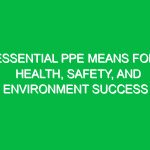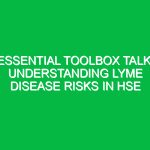In the realm of health, safety, and environmental (HSE) management, personal protective equipment (PPE) stands as a cornerstone of safety practices. This essential gear is designed to protect workers from a variety of hazards, ensuring their safety while they perform their duties. In this article, we will delve into the significance of PPE within the HSE context, exploring its key components, relevant regulations, and best practices. By understanding the vital role that PPE plays, health and environment professionals can take actionable steps to safeguard themselves and their colleagues.
Understanding Personal Protective Equipment (PPE)
PPE, or personal protective equipment, refers to clothing and gear designed specifically to protect individuals from health and safety risks at work. This equipment can include a wide array of items, from hard hats and gloves to respirators and safety goggles. The primary purpose of PPE is to minimize exposure to hazards that can lead to injury or illness.
In the HSE domain, the importance of PPE cannot be overstated. Health professionals, environmental scientists, and safety officers frequently encounter risks such as chemical exposure, biological hazards, and physical dangers. Effective use of PPE is a fundamental part of risk management, helping to create a safer work environment.
Key Components of PPE in HSE
The effectiveness of PPE hinges on its appropriateness for specific hazards. Here are some of the most common types of personal protective equipment used in HSE:
- Head Protection: Hard hats are vital for preventing head injuries from falling objects or bumps. They are crucial on construction sites and in manufacturing environments.
- Eye and Face Protection: Safety goggles and face shields protect against flying debris, chemical splashes, and harmful radiation. For instance, a laboratory technician working with corrosive substances must wear appropriate eyewear to prevent eye damage.
- Respiratory Protection: Respirators and masks safeguard against inhaling harmful dust, fumes, or vapors. In industrial settings, workers may face hazardous air quality, making respiratory protection essential.
- Hand Protection: Gloves made from various materials protect against chemical burns, cuts, and abrasions. Choosing the right type of glove is critical, as not all gloves offer the same level of protection.
- Foot Protection: Safety boots with steel toes protect feet from heavy objects and punctures. They are indispensable in environments where heavy materials are handled.
Assessing Hazards and Selecting the Right PPE
Proper hazard assessment is fundamental to selecting the appropriate PPE. A risk assessment involves identifying potential hazards associated with specific tasks and determining the likelihood and severity of harm. For example, a construction site may present risks such as falling materials, electrical hazards, and exposure to toxic substances.
Once hazards are identified, professionals must choose the right PPE that effectively mitigates those risks. This process often involves consulting safety data sheets (SDS) for chemicals or materials being handled and understanding the limitations of each type of protective gear. For instance, while gloves may offer cut resistance, they may not be suitable for handling chemicals without proper certification.
Best Practices for PPE Usage
To maximize the effectiveness of PPE, certain best practices should be followed:
- Training: All employees should receive training on the correct use, maintenance, and limitations of PPE. This not only promotes safety but also fosters a culture of awareness regarding workplace hazards.
- Regular Inspections: PPE should be inspected regularly for wear and tear. Damaged equipment should be repaired or replaced immediately to ensure continued protection.
- Proper Storage: PPE must be stored in clean, dry areas to prevent contamination and degradation. For example, respirators should be kept in a protective case when not in use.
- Encourage Feedback: Employees should feel comfortable providing feedback about PPE performance. This can lead to improvements in selection and increased compliance with safety measures.
Real-Life Examples of PPE Impact
Consider a case study from a manufacturing facility where workers were exposed to high levels of particulate matter. The company implemented a robust PPE program, including high-efficiency particulate air (HEPA) respirators. As a result, incidents of respiratory issues among workers decreased significantly, demonstrating the tangible benefits of effective PPE usage.
Another example involves healthcare workers during the COVID-19 pandemic. The urgent need for personal protective equipment such as masks, gowns, and face shields became paramount. Institutions that prioritized PPE availability not only safeguarded their staff but also ensured continuity of care for patients.
Regulations and Standards Governing PPE
The use of PPE is governed by several regulations and standards, which vary by country and industry. In the United States, the Occupational Safety and Health Administration (OSHA) sets forth regulations that require employers to provide appropriate PPE to employees at no cost. Under OSHA‘s standards, employers must conduct hazard assessments and select suitable PPE based on the identified risks.
Additionally, the American National Standards Institute (ANSI) provides guidelines for specifying the types of PPE needed in different environments. Compliance with these regulations is crucial for promoting workplace safety and can protect organizations from legal liability.
Future Trends in PPE
The landscape of personal protective equipment is evolving, driven by advances in technology and a growing awareness of environmental sustainability. Innovative materials are being developed that not only provide superior protection but are also more comfortable and lightweight. Additionally, there is a move towards sustainable PPE, with manufacturers exploring recyclable and biodegradable materials.
Smart PPE is another area of growth, incorporating technology such as sensors that monitor environmental conditions and alert workers to potential hazards. This integration of technology in PPE represents a significant step forward in enhancing worker safety and health.
Conclusion
In the ever-evolving field of health, safety, and environment, personal protective equipment remains a vital line of defense against workplace hazards. The thoughtful selection, proper use, and ongoing maintenance of PPE can significantly reduce risks and protect the well-being of workers. By adhering to best practices, staying informed about regulations, and embracing innovation, professionals in the HSE domain can foster a culture of safety and resilience. Ultimately, prioritizing PPE is not just a regulatory requirement; it is a commitment to safeguarding human life and promoting environmental sustainability.


